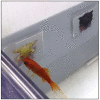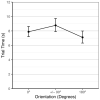Visual Perception of Photographs of Rotated 3D Objects in Goldfish (Carassius auratus)
- PMID: 35883344
- PMCID: PMC9311921
- DOI: 10.3390/ani12141797
Visual Perception of Photographs of Rotated 3D Objects in Goldfish (Carassius auratus)
Abstract
This study examined goldfishes' ability to recognize photographs of rotated 3D objects. Six goldfish were presented with color photographs of a plastic model turtle and frog at 0° in a two-alternative forced-choice task. Fish were tested with stimuli at 0°, 90°, 180°, and 270° rotated in the picture plane and two depth planes. All six fish performed significantly above chance at all orientations in the three rotation planes tested. There was no significant difference in performance as a function of aspect angle, which supported viewpoint independence. However, fish were significantly faster at 180° than at +/-90°, so there is also evidence for viewpoint-dependent representations. These fish subjects performed worse overall in the current study with 2D color photographs (M = 88.0%) than they did in our previous study with 3D versions of the same turtle and frog stimuli (M = 92.6%), although they performed significantly better than goldfish in our two past studies presented with black and white 2D stimuli (M = 67.6% and 69.0%). The fish may have relied on color as a salient cue. This study was a first attempt at examining picture-object recognition in fish. More work is needed to determine the conditions under which fish succeed at object constancy tasks, as well as whether they are capable of perceiving photographs as representations of real-world objects.
Keywords: goldfish; object constancy; object discrimination; picture-object recognition; visual perception.
Conflict of interest statement
The authors declare no conflict of interest.
Figures




Similar articles
-
Visual perception of planar-rotated 2D objects in goldfish (Carassius auratus).Behav Processes. 2018 Dec;157:263-278. doi: 10.1016/j.beproc.2018.10.009. Epub 2018 Oct 24. Behav Processes. 2018. PMID: 30367914
-
Visual perception in a bottlenose dolphin (Tursiops truncatus): Successful recognition of 2-D objects rotated in the picture and depth planes.J Comp Psychol. 2020 May;134(2):180-196. doi: 10.1037/com0000207. Epub 2019 Dec 19. J Comp Psychol. 2020. PMID: 31855032
-
Visual discrimination of rotated 3D objects in Malawi cichlids (Pseudotropheus sp.): a first indication for form constancy in fishes.Anim Cogn. 2014 Mar;17(2):359-71. doi: 10.1007/s10071-013-0667-2. Epub 2013 Aug 28. Anim Cogn. 2014. PMID: 23982620
-
Achieving visual object constancy across plane rotation and depth rotation.Acta Psychol (Amst). 1999 Sep;102(2-3):221-45. doi: 10.1016/s0001-6918(98)00052-3. Acta Psychol (Amst). 1999. PMID: 10504882 Review.
-
The role of color information on object recognition: a review and meta-analysis.Acta Psychol (Amst). 2011 Sep;138(1):244-53. doi: 10.1016/j.actpsy.2011.06.010. Epub 2011 Jul 31. Acta Psychol (Amst). 2011. PMID: 21803315 Review.
References
-
- Jolicoeur P., Humphrey G.K. Perception of rotated two-dimensional and three-dimensional objects and visual shapes. In: Walsh V., Kulikowski J., editors. Visual Constancies: Why Things Look as They Do. Cambridge University Press; Cambridge, UK: 1998. pp. 69–123.
-
- Peissig J.J., Goode T. The recognition of rotated objects in animals. In: Lazareva O.F., Shimuzu T., Wasserman E.A., editors. How Animals See the World: Comparative Behavior, Biology, and Evolution of Vision. Oxford University Press; New York, NY, USA: 2012. pp. 233–246.
LinkOut - more resources
Full Text Sources
Miscellaneous

